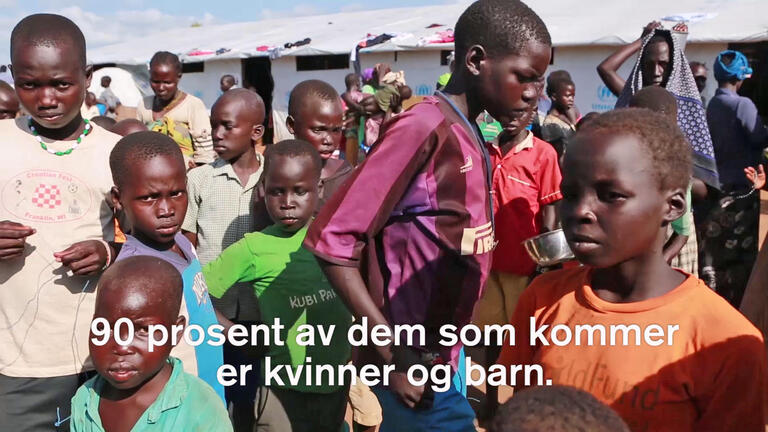

– Vi løp for våre liv for å ikke bli drept. Jeg brukte alle pengene jeg hadde for å føre barna mine i sikkerhet i Uganda, sier Agnes Drabua (35). Hun er én av mange tusen flyktninger som tatt seg over grensen til nabolandet den siste måneden.
Ifølge ferske tall fra FNs høykommissær for flyktninger, har over 85.000 sørsudanske flyktninger tatt seg over grensen til nabolandet Uganda siden de nye stridene brøt ut den 7.juli. Det er mer enn dobbelt så mange som kom under årets første seks måneder. Kapasiteten på mottakssentrene for flyktninger er sprengt. Humanitære organisasjoner og myndighetene gjør alt de kan for å dekke behovene, men de mangler resurser.
– Det store antallet flyktninger har lagt et enormt press på ressursene våre. Vi gjør alt vi kan for å bistå, slik at hjelpen når frem, men det er store utfordringer. Vi har ikke nok medarbeidere og de økonomiske ressursene er for knappe til å dekke alle behovene, sier Emmanuel Adowa ved Flyktninghjelpens kontor i Adjumani.
%20flyktet%20med%20de%20fem%20barna%20sine%20til%20uganda%20da%20konfliktene%20startet%20i%20juli.%20na%CC%8A%20venter%20hun%20pa%CC%8A%20plass%20i%20en%20av%20bosetningene.%20.jpg?width=768&height=512)
Halverer matrasjonene
Ute på den åpne plassen er det trangt. Mottakssenteret Nyumanzi, som er laget for å kunne ta imot rundt 2000 flyktninger, er i dag hjem til over 13.000 sørsudanske flyktninger.
– Senteret er sprengfullt og vi klarer ikke lenger å gi folk nok mat. Nå i august er vi blitt nødt til å halvere matdistribusjonen til dem som allerede er bosatt her for å klare å hjelpe de nyankomne, sier Albert Alumbi, som er bosetningskoordinator ved myndighetenes kontor i
Nyumanzi.
Vi er fredelige folk. Jeg ønsker bare fred og en trygg fremtid for mine barn.Agnes Drabua, sørsudansk flyktning
Kolera-utbrudd
Rundt 90 prosent av alle de sørsudanske flyktningene i Uganda er kvinner og barn. Agnes Drabua (35) sitter med de fem barna rundt seg i den nyåpnede bosetningen Pagirinya. Som majoriteten av kvinner her kom hun alene med barna over grensa.
– Vi er fredelige folk. Jeg ønsker bare fred og en trygg fremtid for mine barn, sier Drabua.
Bosetningen Pagrinya er bare uker gammel, men allerede hjem til over 27.000. Et kolerautbrudd for få dager siden har lagt et enda større press på ressursene i området.
– Vi identifiserte først to pasienter med kolera. Nå er tallet steget til 37 personer og kolera-teamet i området jobber hardt for å stoppe spredning, sier Ahmed Rasul, helsearbeider på klinikken i Pagrinya.
– Vi har blitt nødt til å etablere strikte rutiner for hygiene. Den store utfordringen er at bosetningen er så full. Vi jobber nå med å få omplassert folk herfra til den nyeste bosetningen i området Yumbe, sier Vincent Amaroma, bosetningsassistent ved myndighetenes kontor i Pagrinya.
Den store utfordringen er at bosetningen er så full.Vincent Amaroma, bosetningsassistent
Flykter fra matmangel
Sør-Sudan er i dag en av verdens største humanitære kriser. Ifølge FNs høykommissær for flyktninger har bortimot én million flyktninger tatt seg over grensen til nabolandene Sudan, Uganda, Etiopia og Kenya. Inne i landet er over 1,6 millioner mennesker på flukt. Flyktningene som kommer over grensa forteller om brutale drap, rebeller som brenner ned hus og militæret som presser folk på penger.
På grensa i Elegu har de siste dagene vært mindre hektiske, men det passerer fortsatt en jevn strøm med flyktninger. Selv om konfliktene i Sør-Sudan har roet seg siden stridene brøt ut i begynnelsen av juli, er situasjonen fremdeles spent.
– I går kom flere politifolk over grensa med familiene sine. Det sier litt om sikkerhetssituasjonen i landet. Nå som stridene har roet seg, er matmangel en av de viktigste grunnene til at folk flykter. Vi har fortsatt plass til flere, men snart er det stopp, sier Frida Kajoki, registreringsansvarlig ved Elegu.

Født på flukt
På gulvet i et telt sitter Alice Drama (24) med sin to uker gamle baby. Sønnen hennes er ett av mange barn som er født på flukt. Den nyfødte puster tungt. Inne i teltet er det stekende varmt. Drama flyktet høygravid over grensen etter at mannen forlot henne for en annen kone. Nå drømmer hun om et fredelig liv og en trygg fremtid for sin sønn.
– Jeg er så lei av krigen. Jeg orker ikke lenger å være redd. Nå tenker jeg på fremtiden til gutten min. Jeg håper den blir fin, sier Drama.
Mens flyktningene i Sør Sudans naboland Uganda blir stadig flere, fortsetter krigen å herje i verdens yngste land.


-scr%20(1).jpg?width=768&height=384)

